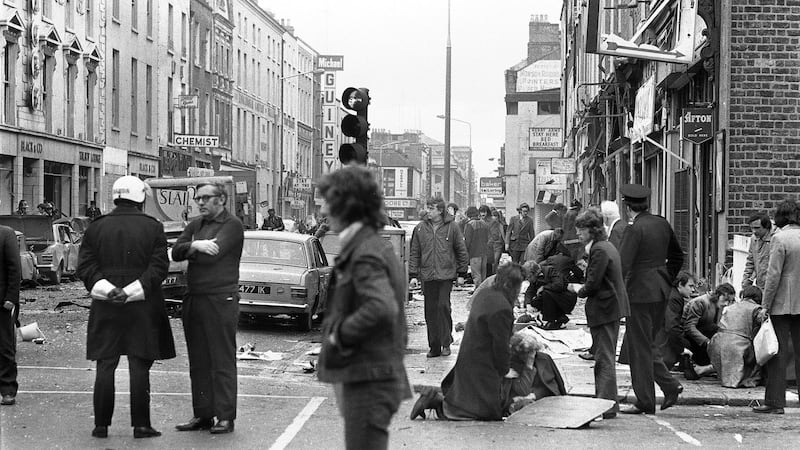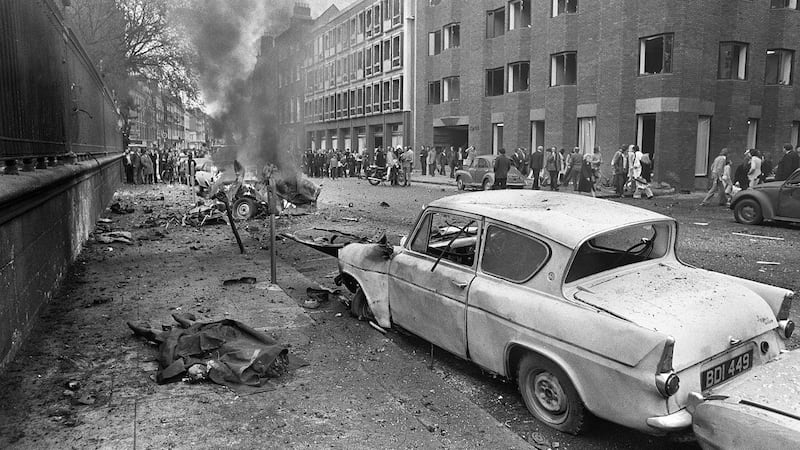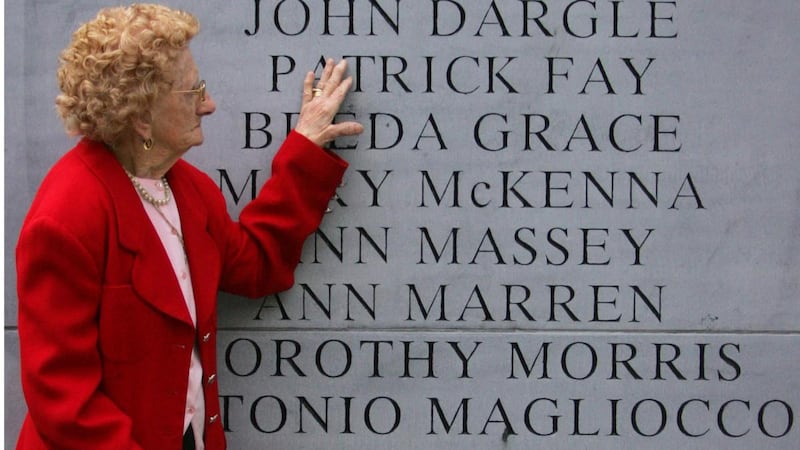May 17th, 1974, was the worst day of the Troubles. Three car bombs exploded in Dublin city centre, the first at 5.28pm on Parnell Street, the second at 5.30pm on Talbot Street and the third at 5.32pm on South Leinster Street. At 6.58pm another car bomb exploded, on North Road in Monaghan town.
As a result of these four car bombs, 33 people died, as did a full-term baby, and almost 300 people were treated for injuries. Many more hundreds of witnesses saw the outcomes of this terrorist attack: dead bodies, dying men, women and children, decapitated corpses, mutilated limbs and a motherless toddler wandering the streets, too shocked to cry. People saw things that cannot be unseen.
My mother, brother and I survived that day. We were crossing from Talbot Street to North Earl Street at the time of the second explosion. Mam threw me into the pram with my little brother and ran for our lives.
May Day 1974, my new collection, contains 33 ode-ballads and 33 docu-sonnets to commemorate the dead, including the six pairs that appear below. The ode-ballads, which are named for each victim, are the products of my imagination. The docu-sonnets that precede them are crafted verbatim, except where small changes were needed for metre and form, hewn from bereaved families’ testimonies in the public domain: Oireachtas statements, coroner’s depositions, YouTube footage and a documentary, Hidden Hand: The Forgotten Massacre.
Even though witnesses were able to identify the drivers of the stolen cars that carried the explosives, no one has ever been charged or brought to court. The grieving families and survivors are still awaiting a public inquiry, the truth and justice.
For Marie Phelan
Marie Phelan was 20. She worked in the Civil Service. Originally from Ballyvoreen, Woodstown, Co Waterford, and living in Dublin, she was survived by her parents, Kitty and Billy, and brothers, Pat and Anthony. Marie was killed in the Talbot Street explosion
Anthony Phelan's statement to the Oireachtas Public Hearings on the Barron Report, 20.1.2004
My name is Anthony Phelan and I am from Waterford.
My sister was 20 years of age when she was killed in Talbot Street.
I was 13 years old at the time and was going to school.
My sister Marie had been working in Dublin for one year.
She was an outgoing and jolly girl who worked in the Civil Service.
On the 17th of May she was invited to a party with some friends.
They decided to take a shortcut, towards Talbot Street,
to buy a present. She usually never walked home that way.
Marie walked down Talbot Street and was outside Guineys,
just past where the car blew up, when she was killed.
My parents were told that my sister was unrecognisable.
My father was not allowed to see his daughter's body.
We have relations in Dublin and they informed my father
Marie could only be recognised by the ring she was wearing.
Marie Phelan
The things I miss most in this city
are the ditches and hedgerows.
Here it's all footpaths, granite slabs,
sharp-edged curbs and gutters.
On sunny days, all this concrete
bakes my feet. I long for barefoot
grass-racing out the back fields
and maybe a little paddle in the Suir.
Where do children play hide
and go seek in a city? I lost hours
of my childhood hiding under bushes
or sheltering from summer heat
in the cold dark of meadow gullies.
I loved to poke at roots, pull up threads
of weeds or see how sticky-backs
fared on the fronts of my sky-blue wellies.
I'd bask in the shadows and light beams
of a robin's hedge as me lil' brothers roared
'Coming, coming, ready or not,
keep your place or you'll be caught.'
For Siobhán Roice
Siobhán Roice was 19. She worked in the Civil Service. Originally from Thomas Street, Wexford town, and living in Dublin, she was survived by her parents, Johanna and Edward, sisters, Aileen and Elizabeth, and brother, James. Siobhán was killed in the Talbot Street explosion
Edward Roice's statement to the Oireachtas Public Hearings on the Barron Report, 20.1.2004
Friday, the 17th of May 1974, was a turning point in my family's lives.
It was the day I lost my beautiful 19-year-old daughter, Siobhán.
From that day, our lives were never to be the same.
It has broken our hearts and left my wife a very sad mother.
My wife and I were in our early fifties when Siobhán was murdered,
or, I should say, when 33 people were slaughtered on Irish streets.
My wife and I are now senior citizens, in our early eighties, still trying
to get answers to the questions and the truth that has been denied to us.
Would anybody, as a parent, not move every stone to get the answers?
The truth is that justice has been denied to us for over the 30 years.
As a parent, I appeal to the committee members to do something
that they would not deny their own children if the situation were reversed.
Hopefully they will never experience this grief, loss and deep sadness.
We demand nothing less than a full public inquiry. I thank the committee.

Siobhán Roice
There's this boy, well man,
two desks up from mine.
I'd say he's a couple of years on me,
but only the couple mind.
The thing is, he blushes
when I catch him looking
over at me. Goes rose red,
bends his head and back
to work with him. He scribbles
on his note pad with great gusto
'cause he knows he's been snared,
caught gazing at the new girl.
Sometimes, for pure boldness,
I get up from my chair and walk
slowly by his desk. Let on
to be vexed with a dulled pencil,
make a to-do at the walled sharpener.
Stare at the back of his sandy hair
and think of walks on Curracloe beach.
For Breda Turner
Breda Turner was 21. She worked in the Civil Service, in the income-tax office. She was engaged to be married the following Easter. Originally from Thurles, Co Tipperary, and living in Dublin, she was survived by her parents, Biddy and Jimmy, and brother and sisters. She was killed in the Parnell Street explosion
Marie Power's statement to the Oireachtas Public Hearings on the Barron Report, 20.1.2004
I am here today on behalf of my father, brothers and sisters.
My sister, Breda, died in the Parnell Street bombings
and that Friday evening changed all our lives.
Breda was in a flat in Dublin. We did not have a telephone
and when the news flash came on the television I went down
to a public telephone to ring her to see if she was all right.
There was no answer. Then I rang her boyfriend and he tried
to contact her. That was it. That night the gardaí came.
I never thought she was really gone until I saw her memorial card.
That was when I really knew she was not coming back.
She was 21, engaged to be married, her whole life in front of her.
She was to have been my bridesmaid the following March.
We had to get through that day and many more without her.
That is all I can think of, I had more to say but it's gone now.
Breda Turner
I was always good at maths.
My father said I had a head
for figures and could do mental
arithmetic no bother.
I was the first in our class
to figure out long division
and that was it –
my fate was sealed.
It was maths prizes here,
honours papers there,
Civil Service exams,
then a fast track – away you go.
They have me totting up
income tax, PAYE,
PRSI, marginal rates,
high rates – I ask you.
I'm tired of swottin' the numbers.
I'm more interested now
in the more interesting maths
of mating and marriage.
How one and one makes two . . . or more.
For Colette Doherty
Colette Doherty was 21. She ran a shop on Sheriff Street with her husband, John. She was nine months pregnant when she was killed on Talbot Street. She was survived by her husband, 22-month-old daughter, Wendy, parents, Michael and Winifred, and siblings. Wendy, who was with her when she was killed, was found wandering an hour later, relatively unharmed
Michael McCarthy's deposition and statement at the Coroner's Court, 27.04.04
I am Michael McCarthy, a brother of the deceased, Colette Doherty.
My sister was at home on Sheriff Street on the 17th of May 1974.
I was working at the shop Colette and her husband John ran
when Colette left to go shopping on Henry Street and Talbot Street.
She went with her daughter Wendy, who was nearly two years old.
Colette's second baby was due on Sunday the 19th of May
and she wanted to do some last-minute shopping in town.
Later, a chap came into the shop and told John about the bombs.
John went to look for Colette and Wendy. I stayed in the shop.
Colette had been on her way home, with Wendy in her buggy,
when the bomb exploded on Talbot Street. Colette was found
in the City Morgue. We still don't know about her unborn baby.
Wendy was found wandering Talbot Street hours after the bomb.
She was found, safe and well, by a neighbour from Sheriff Street.
Colette Doherty
The best thing about my Wendy
is her walk. She is so sturdy now.
No more waddle in her toddle,
not a bit of fear. She's well able.
It's mad. I'm big-belly slow
and she's small feet, all go.
Lately she's taking to orbiting me.
Making wider and wider circles
around her small, small world.
I'm still her centre but
she's meeting things for herself.
No longer living on me hip.
And she's startin' to give lip.
No, no no. No is her favourite
thing to say. Even her father
gets an earful. And he takes it.
Then again, at night she's back
to being all mine. Still sleeps
between himself and meself.
It'll be the craic with the new baby.
We’ll just shove over for one more.
For Anna Massey
Anna Massey was 21. She worked at Lisney’s Auctioneers. From Sallynoggin, Co Dublin, she was the eldest of seven girls, and a twin. She was survived by her parents, Frank and Annie, and sisters. She was engaged to be married; her wedding was to take place in July 1974. Anna was killed in the South Leinster Street explosion
Frank Massey's statement to the Oireachtas Public Hearings on the Barron Report, 20.01.2004
Our Anna was murdered in Leinster Street on the 17th of May 1974.
We are bitterly disappointed in the failures of the Barron Report.
Justice Barron's investigation was thwarted by lack of access to files
in possession of the British government or our gardaí's missing files.
A public inquiry is essential to establish the truth of what happened
in the aftermath of 33 murders and the injuries of hundreds of people.
On the night of the bombings the taoiseach, Liam Cosgrave, promised
to leave no stone unturned until those responsible were brought to justice.
Thirty years have not diminished the families' sorrow and frustration.
I'm now 80 and have fought long and hard for justice for our Anna.
This is probably my last opportunity to press my concerns but my family
will continue to strive for the truth and seek justice for the forgotten.
I am an ordinary citizen and the father of a beautiful, murdered child.
I hope our Anna and the others will not be disappointed in our efforts.

Anna Massey
Nobody tells you how much work
a wedding involves. Every lunch hour
I leave work to do the jobs
for the big day. The big day is right.
Flowers, photographers, cakes,
hotel seating charts, menu options,
wedding bands, bridesmaid dresses,
fittings and lingerie. Don't talk to me.
Mam says they didn't have that
back in her day. And I wish
I was back in her day. The aunt
says I need a going-away outfit.
Something to wear, says she
with a wink, as we wave you off,
down the road to the wedding night
and the rest of your life.
I went puce when she said that.
I'm excited and a bit scared too.
I can only say it to me twin.
She just smiles, gives me a nudge
and tells me to go on outta that.
For Anna O’Brien
Anna O’Brien was 22. Originally from Finglas in Dublin, she lived on Gardiner Street, in the city centre. Her husband, John, who was 24, worked at Palm Grove, the ice-cream factory. They and their daughters, 17-month-old Jacqueline and five-month-old Anne-Marie, were all killed in the Parnell Street explosion
Alice O'Brien's statement to the Oireachtas Public Hearings on the Barron Report, 20.01.2004
My name is Alice O'Brien. I lost my sister, her husband
and their two children in the 1974 bombing on Parnell Street.
My sister was 22 years old, Jacqueline was 17 months old
and the baby, Anne Marie, was just five months. They lived
around the corner from Parnell Street on Gardiner Street.
My aunt lived across from Anna. She alerted the house in Finglas
that Anna had not come home all night. Paddy Doyle, my father,
and my mother's sister, Christine Conroy, went to the mortuary.
Paddy identified Jacqueline and Anne Marie
because they were the only two babies killed,
but he could not identify Anna at all.
He identified Johnny by a tattoo on his arm
that had "Anna and Johnny" on it. Anna was identified
when Christine Conroy recognised my sister's earring.

Anna O'Brien
What I miss about Finglas
are the trees, the trees by the Tolka.
The river made the valley
and the valley gave us trees.
When the priest in Gardiner Street drones on,
I mouth me prayers, like the others.
But really, I do be back by the Tolka
walking the trail of trees in me head.
I hear me Granny's voice,
soft whisperings over the rattle of rosaries,
and her telling me trees never sin.
She names off the trees and their markers.
The willow with its weeping limbs,
the ash and its papery bark,
the oak's sturdy trunk and tiny toppers
and the hazel with its nuts for hungry gaps.
When the time comes, I'll show our girls
the markers for different kinds of trees.
I'll take them to the elder where me and John
carved out our names when we was courtin'.
They'll likely laugh at us auld wans, once young
and carving love on a tree by the Tolka.
May Day 1974 is published by Salmon Poetry; it will be launched by Catriona Crowe on Friday, May 17th, at 6pm, in the Joly Theatre at Trinity College Dublin

















